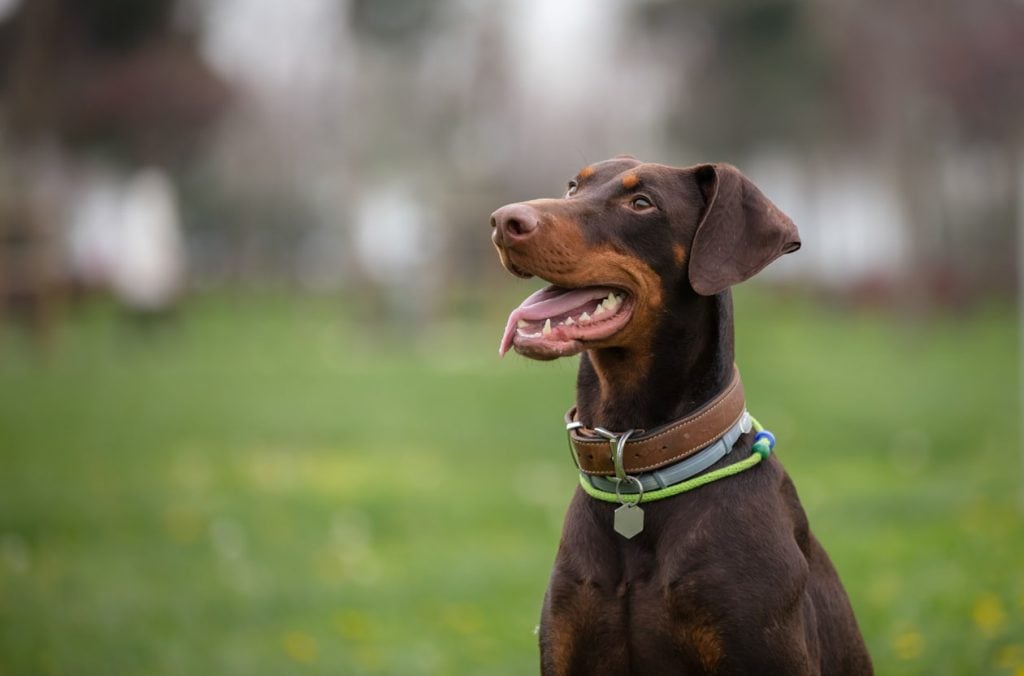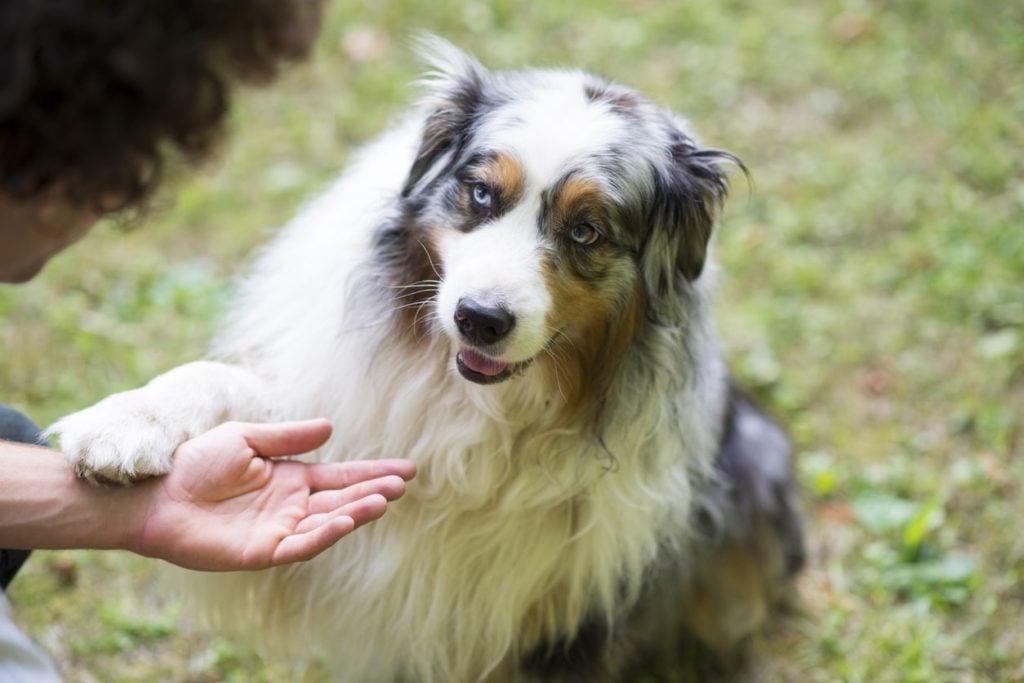- Not a substitute for professional veterinary help.
All dogs can learn new skills and tricks—they always amaze us with what they can do! But what does it mean when people say a dog is “easy to train”?
Easy to train means how quickly the dog learns basic commands like ‘sit’ or ‘stay,” says Daniel Neale, a dog behaviorist at Shelby Semel Dog Training. Dogs who learn quickly are often easy to motivate and are known as “biddable” as they respond well to treats and praise. Common easy-to-train breeds include Border Collies, German Shepherds, and Golden Retrievers.
We highlight the pros and cons of the top easiest-to-train dog breeds and walk through other factors that impact your dog’s training positively.
1. Border Collies
Border Collies are friendly, loyal, and energetic dogs. They are very smart and love to work! These dogs were originally herding dogs, so they enjoy being busy. They can learn many things, from basic commands like “sit” to fun tricks and even important jobs like search and rescue. Some Border Collies can even recognize over 100 different toys by name!
However, if kids are in the house, Border Collies might try to herd them by nipping at their ankles. This behavior can be trained away, though! Just like any dog, they need enough exercise and fun activities. Otherwise, they might get into trouble by chewing on things.
2. Poodles
Poodles are playful, friendly, and super smart! They were bred to help catch ducks in the water. Because they are sensitive, they do best with positive training and short, fun sessions.
Poodles can bark a lot and may feel anxious when left alone, so they need consistent training and rewards to help them feel comfortable.
3. Golden Retrievers
Golden Retrievers are outgoing, fun, and loyal dogs. They are great family pets because they are eager to please and can learn all kinds of tricks.
While Golden Retrievers aren’t the most hyper dogs, they still need lots of exercise and mental activities. They might chew on furniture or get bored if they don’t get enough.
4. German Shepherds
German Shepherds are loyal and hardworking. They love to learn new tricks and enjoy challenges. This working breed can be employed as service dogs, police dogs, and more.
They thrive on being active and spending time with their families. Since they are protective, they might be cautious around strangers, so it’s important to train them well.
5. Doberman Pinschers
Doberman Pinschers are smart and athletic. They need consistent training and socialization when they’re young. These energetic dogs can get bored easily, so short and fun training sessions are important.
If left alone too long, they might develop anxiety and chew on things, so they need plenty of exercise and activities.

iStock/Berk Ucak
6. Boxers
While their muscular bodies and sometimes intimidating gaze can be deceiving, Boxers are friendly and protective dogs. They are very smart and energetic, making them great learners.
However, they can be stubborn, so training them well when they’re puppies is important. Because they are big dogs, strong leash training is necessary to keep them under control.
7. Papillons
Papillons are happy, loyal, and playful dogs. Often seen as one of the smartest dog breeds, they love to cuddle and play. These small dogs have big personalities and lots of energy!
While they can learn many tasks, Papillons don’t like being left alone. They might get into trouble if they don’t get enough exercise or playtime.
8. Bernese Mountain Dogs
Bernese Mountain Dogs are gentle and loving. They want lots of attention and enjoy training and exercise. These dogs are great with kids and other pets.
Due to their massive size, early socialization and obedience training are essential. Like other giant breeds, Bernese Mountain Dogs reach full maturity around three years old. It may take them longer compared to smaller breeds to pick up on potty training since they don’t have full bladder strength until they reach six months old.
9. Labrador Retrievers
Labrador Retrievers consistently rank as one of the most popular dog breeds in the United States—and for good reason. They’re lively, loyal, and loving family dogs! Given their origins, they always want to carry things in their mouths and drop them at your feet, says Geralynn Cada, MBA, an award-winning professional dog trainer and pet product expert.
While Labs are easy to potty train, they need lots of exercise and enrichment to be happy and healthy. They also may be more prone to separation anxiety and excessive barking. Lastly, while researchers have debunked the myth that chocolate labs are more aggressive than yellow or black Labs, they might be “less trainable.”
10. Shetland Sheepdogs
Cada says Shetland Sheepdogs, or Shelties, are loyal, patient, and kind dogs. They’re also highly intelligent and observant, which helps them pick up a task quickly.
“Their ability to learn and repeat a task places them in the upper 10% of all breeds,” she says. However, they also love sitting in your lap or becoming couch potatoes.
You can usually expect Shelties to master potty training quickly if there are no genetic or medical issues.

iStock/LittleCityLifestylePhotography
11. Australian Shepherds
Australian Shepherds are highly intelligent and energetic dogs. Cada says this herding breed will watch your every move and memorize your patterns—they may eventually try herding you into your routine!
Australian Shepherds require ample physical activity and mental stimulation to be at their best. Cada considers potty training to be challenging since these herders can hold their bladder for long periods of time while they work.
12. Bichons Frises
The Bichon Frise is a fun, affectionate, bright, and cuddly companion! They can learn new tricks quickly just by watching, and potty training is usually easy for them unless there are health issues. However, she’s owned several and believes males could require extra training in this area.
These little white dogs are highly adaptable and happy-go-lucky, wanting nothing more than to make friends with everyone and please their loved ones.
What Affects Trainability?
Any dog, no matter their breed, can be trained well! Neale says the following can determine how quickly your dog trains:
- Reinforcement history
- A pet parent’s familiarity with training
- A dog’s personality
- Food motivation
- Distractions
- Past experiences
- Trust in their trainer
Dog Trainability FAQs
Are some dog breeds harder to train?
It depends on the dog. Some don’t mature fully until they are 2 to 3 years old, and some may be more stubborn or easily bored during training. These dogs just need extra patience and consistency.
Sometimes, keeping training sessions short and fun can help them learn better.
How do mixed breeds react to training?
Neale says mixed dog breeds can be different to train compared to purebred dogs.
“There’s growing evidence that behavior can have a genetic component,” he explains. The way a dog behaves can be influenced by its genes. However, a mixed breed is not just a mix of the best traits. They can also have an unpredictable combination of characteristics that make them harder to train.
Training a mixed breed dog can be less predictable if you don’t know the dog’s full DNA background.
Do you need a trainer for easy-to-train dog breeds?
Yes, Cada says pet parents should hire a qualified dog trainer for any breed. Working with a trainer can help you understand your dog better and prevent accidents. It also helps create a successful relationship between you and your pup.
How long does it take to train a dog?
Cada says every breed learns at their own pace. While the training time can vary, most dogs will respond to training in about 2 to 12 weeks.
If genetic or medical reasons affect this time, it’s best to consult your veterinarian.
What is the best age to train a dog?
The best age to start training a dog is between 8 and 10 weeks old, or right when you bring them home. At this age, training should focus on potty training, body sensitivity training, and socialization.
What training techniques work best?
The best and most effective training techniques are positive reinforcement and clicker training. These methods reward good behavior with training treats, toys, or praise, which helps build your dog’s confidence and strengthens the bond between you and your dog.
What should I avoid when training a dog?
Avoid using negative or punishment-based training methods. These techniques can lead to more unwanted behavior and damage your relationship with your dog.
Can older dogs still be trained?
Yes! “With the proper motivation, any dog—young or old—can learn new tricks and even behavior modification,” Cada says. It just takes time and patience.
Do dogs need training throughout their lives?
Yes. Once you start training, Cada says it needs to be reinforced throughout their lives. Just like people, dogs (and even cats) need reminders about how to behave.



